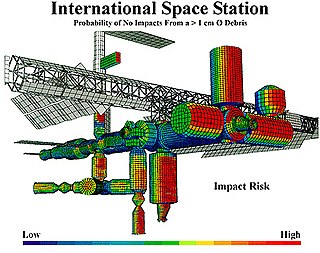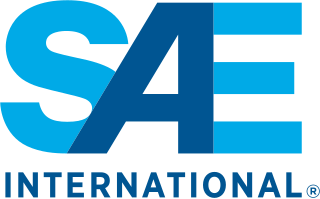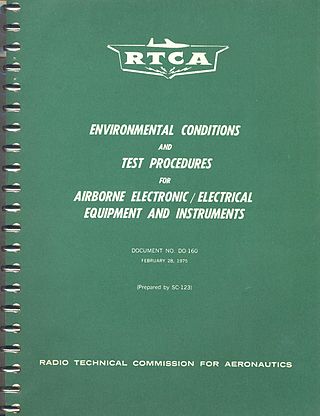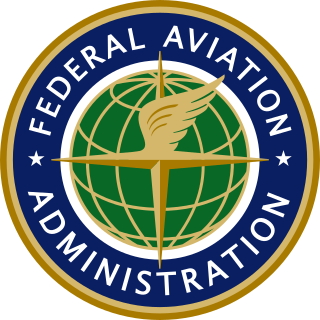
Safety engineering is an engineering discipline which assures that engineered systems provide acceptable levels of safety. It is strongly related to industrial engineering/systems engineering, and the subset system safety engineering. Safety engineering assures that a life-critical system behaves as needed, even when components fail.
DO-178B, Software Considerations in Airborne Systems and Equipment Certification is a guideline dealing with the safety of safety-critical software used in certain airborne systems. It was jointly developed by the safety-critical working group RTCA SC-167 of the Radio Technical Commission for Aeronautics (RTCA) and WG-12 of the European Organisation for Civil Aviation Equipment (EUROCAE). RTCA published the document as RTCA/DO-178B, while EUROCAE published the document as ED-12B. Although technically a guideline, it was a de facto standard for developing avionics software systems until it was replaced in 2012 by DO-178C.
A hazard analysis is one of many methods that may be used to assess risk. At its core, the process entails describing a system object that intends to conduct some activity. During the performance of that activity, an adverse event may be encountered that could cause or contribute to an occurrence. Finally, that occurrence will result in some outcome that may be measured in terms of the degree of loss or harm. This outcome may be measured on a continuous scale, such as an amount of monetary loss, or the outcomes may be categorized into various levels of severity.

ARP4761, Guidelines for Conducting the Safety Assessment Process on Civil Aircraft, Systems, and Equipment is an Aerospace Recommended Practice from SAE International. In conjunction with ARP4754, ARP4761 is used to demonstrate compliance with 14 CFR 25.1309 in the U.S. Federal Aviation Administration (FAA) airworthiness regulations for transport category aircraft, and also harmonized international airworthiness regulations such as European Aviation Safety Agency (EASA) CS–25.1309.
RTCA DO-254 / EUROCAE ED-80, Design Assurance Guidance for Airborne Electronic Hardware is a document providing guidance for the development of airborne electronic hardware, published by RTCA, Incorporated and EUROCAE. Initially released in 2000, the DO-254/ED-80 standard was not necessarily considered policy until recognized by the FAA in 2005 through AC 20-152 as a means of compliance for the design assurance of electronic hardware in airborne systems. The guidance in this document is applicable, but not limited, to such electronic hardware items as

DO-160, Environmental Conditions and Test Procedures for Airborne Equipment is a standard for the environmental testing of avionics hardware. It is published by the Radio Technical Commission for Aeronautics (RTCA) and supersedes DO-138.
Functional safety is the part of the overall safety of a system or piece of equipment that depends on automatic protection operating correctly in response to its inputs or failure in a predictable manner (fail-safe). The automatic protection system should be designed to properly handle likely systematic errors, hardware failures and operational/environmental stress.
DO-178C, Software Considerations in Airborne Systems and Equipment Certification is the primary document by which the certification authorities such as FAA, EASA and Transport Canada approve all commercial software-based aerospace systems. The document is published by RTCA, Incorporated, in a joint effort with EUROC and replaces DO-178B. The new document is called DO-178C/ED-12C and was completed in November 2011 and approved by the RTCA in December 2011. It became available for sale and use in January 2012.
Zonal Safety Analysis (ZSA) is one of three analytical methods which, taken together, form a Common Cause Analysis (CCA) in aircraft safety engineering under SAE ARP4761. The other two methods are Particular Risks Analysis (PRA) and Common Mode Analysis (CMA). Aircraft system safety requires the independence of failure conditions for multiple systems. Independent failures, represented by an AND gate in a fault tree analysis, have a low probability of occurring in the same flight. Common causes result in the loss of independence, which dramatically increases probability of failure. CCA and ZSA are used to find and eliminate or mitigate common causes for multiple failures.
Automotive Safety Integrity Level (ASIL) is a risk classification scheme defined by the ISO 26262 - Functional Safety for Road Vehicles standard. This is an adaptation of the Safety Integrity Level (SIL) used in IEC 61508 for the automotive industry. This classification helps defining the safety requirements necessary to be in line with the ISO 26262 standard. The ASIL is established by performing a risk analysis of a potential hazard by looking at the Severity, Exposure and Controllability of the vehicle operating scenario. The safety goal for that hazard in turn carries the ASIL requirements.

Advisory circular (AC) refers to a type of publication offered by the Federal Aviation Administration (FAA) to "provide a single, uniform, agency-wide system … to deliver advisory (non-regulatory) material to the aviation community." Advisory circulars are now harmonized with soft law Acceptable Means of Compliance (AMC) publications of EASA, which are nearly identical in content. The FAA's Advisory Circular System is defined in FAA Order 1320.46D.

AC 25.1309–1 is an FAA Advisory Circular (AC) that identifies acceptable means for showing compliance with the airworthiness requirements of § 25.1309 of the Federal Aviation Regulations, which requires that civil aviation equipment, systems, and installations "perform their intended function under foreseeable operating conditions." The present Revision B was released in August 2024. AC 25.1309–1 establishes the principle that the more severe the hazard resulting from a system or equipment failure, the less likely that failure must be. Catastrophic failures must be extremely improbable.

FAA Order 8130.34D, Airworthiness Certification of Unmanned Aircraft Systems, establishes procedures for issuing either special airworthiness certificates in the experimental category or special flight permits to unmanned aircraft systems (UAS), optionally piloted aircraft (OPA), and aircraft intended to be flown as either a UAS or an OPA.

The Advisory Circular AC 20-115( ), Airborne Software Development Assurance Using EUROCAE ED-12( ) and RTCA DO-178( ), recognizes the RTCA published standard DO-178 as defining a suitable means for demonstrating compliance for the use of software within aircraft systems. The present revision D of the circular identifies ED-12/DO-178 Revision C as the active revision of that standard and particularly acknowledges the synchronization of ED-12 and DO-178 at that revision.

FAA Order 8110.105B, Airborne Electronic Hardware Approval Guidelines is an explanation of how Federal Aviation Administration (FAA) personnel can use and apply the publication

The Advisory Circular AC 20-152A, Development Assurance for Airborne Electronic Hardware, identifies the RTCA-published standard DO-254 as defining "an acceptable means, but not the only means" to secure FAA approval of electronic hardware for use within the airspace subject to FAA authority. With the 2022 release of Revision A, this Advisory Circular becomes a very important instrument for completing some guidance of DO-254 and providing applicants with clarifications and additional information on that standard.
DO-248C, Supporting Information for DO-178C and DO-278A, published by RTCA, Incorporated, is a collection of Frequently Asked Questions and Discussion Papers addressing applications of DO-178C and DO-278A in the safety assurance of software for aircraft and software for CNS/ATM systems, respectively. Like DO-178C and DO-278A, it is a joint RTCA undertaking with EUROCAE and the document is also published as ED-94C, Supporting Information for ED-12C and ED-109A. The publication does not provide any guidance additional to DO-178C or DO-278A; rather, it only provides clarification for the guidance established in those standards. The present revision is also expanded to include the "Rationale for DO-178C/DO-278A" section to document items that were considered when developing DO-178B and then DO-178C, DO-278A, and DO-330, as well as the supplements that accompany those publications.

The Boeing 737 MAX was initially certified in 2017 by the U.S. Federal Aviation Administration (FAA) and the European Union Aviation Safety Agency (EASA). Global regulators grounded the plane in 2019 following fatal crashes of Lion Air Flight 610 and Ethiopian Airlines Flight 302. Both crashes were linked to the Maneuvering Characteristics Augmentation System (MCAS), a new automatic flight control feature. Investigations into both crashes determined that Boeing and the FAA favored cost-saving solutions, which ultimately produced a flawed design of the MCAS instead. The FAA's Organization Designation Authorization program, allowing manufacturers to act on its behalf, was also questioned for weakening its oversight of Boeing.
The Advisory Circular AC 00-69, Best Practices for Airborne Software Development Assurance Using EUROCAE ED-12( ) and RTCA DO-178( ), initially issued in 2017, supports application of the active revisions of ED-12C/DO-178C and AC 20-115. The AC does not state FAA guidance, but rather provides information in the form of "best practices" complementary to the objectives of ED-12C/DO-178C.
The Certification Authorities Software Team (CAST) is an international group of aviation certification and regulatory authority representatives. The organization of has been a means of coordination among representatives from certification authorities in North and South America, Europe, and Asia, in particular, the FAA and EASA. The focus of the organization has been harmonization of Certification Authorities activities in part though clarification and improvement of the guidance provided by DO-178C and DO-254.





